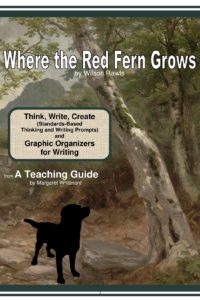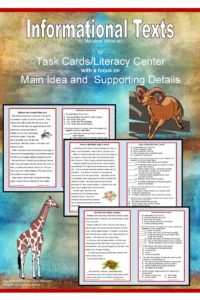
CCSS Aligned
Showing all 3 results
-

Where the Red Fern Grows Thinking and Writing Prompts and Graphic Organizers for Writing
$10.50Add to cartThis 38-page resource for teaching Wilson Rawls’s classic novel has two components.
Where the Red Fern Grows Thinking and Writing Prompts
The Think, Write, Create section offers a series of open-ended activities based on the higher level thinking skills of Bloom’s Taxonomy and specific CCSS skills. The items are organized as a section of chapter-by-chapter activities and a second group of whole-book, post-reading challenges. Difficulty levels are varied to accommodate the needs of individual students including the gifted. Elements of literature and vocabulary building are targeted in some of these activities. Where applicable, targeted CCSS skills are listed at the end of the prompts.Where the Red Fern Grows Graphic Organizers for Writing
The second component is a group of 14 Graphic Organizers that spring from a specific story event, idea, or character. Each topic offers opportunity for improving and polishing composition skills. This 38-page resource for teaching Wilson Rawls’s classic novel has two components.Special Note The two components in this file are included in the full Novel Study Guide listed first on this page. Please do not duplicate your order.
-

Informational Texts for Task Cards/Literacy Centers–Main Idea
$8.00Add to cartThe 12 informational articles in “Things I Didn’t Know About Animals” are designed to help students grasp the concept of main idea and spot supporting details. The texts are short, compact, and filled with unusual and interesting facts to motivate young readers.
The Task Card/Literacy Center format in this download is a single, full-page presentation with the article on the left and a set of 3-5 questions on the right. In addition to main idea and supporting details the questions also address sequencing, cause and effect, inference, and using context clues to determine word meaning.Answer forms are included. This format can be used as a whole class lesson.
Full answer keys are included.
These pages are appropriate for 4th-6th grade classrooms and some 7th and 8th grade students. Motivated 3rd graders will also enjoy these articles.
View Sample Pages HERE.This set of informational texts are also as Interactive Notebook Pages.
-

Informational Text Pack for January: Peanuts and Peanut Butter
$6.50Add to cartThis Informational Text Pack begins with “January 24th: National Peanut Butter Day in the U.S.”. The article focuses on one of our favorite foods and traces its development from its South American roots, through its growth in popularity, to its debut as a homogenized smooth or crunchy commercial product. It also introduces students to “arachibutyrophobia,” the terrible, awful, debilitating fear of getting peanut butter stuck to the roof of one’s mouth.
The second article “How the Peanuts Gang Got Its Name” takes a look at how Charles Schulz was forced to give up the original name he attached to his famous cast of characters and accept one he never warmed up to—“Peanuts!”
Each text is two pages long and comes with a set of 15 CCSS aligned questions.
Full answer keys, with specific CCSS alignments listed for each question, are included.As a bonus, I have added a two-page list of left-over peanut and peanut butter facts that students can use to write their own informational texts. Or, teachers can easily transform them into task cards.
Download the sample pages HERE. (Use back arrow to return to this page.)







